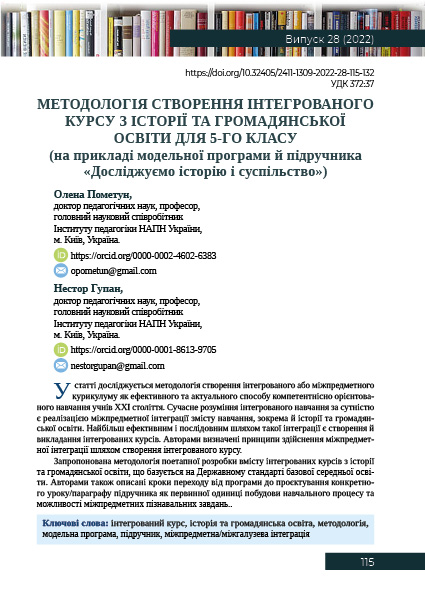Methodology of creating an integrated course of history and civic education for the 5th grade

Published 2022-07-20
Keywords
- integrated course,
- history and civic education,
- methodology,
- model curriculum,
- textbook
- intersubject /interdisciplinary integration ...More
How to Cite

This work is licensed under a Creative Commons Attribution-NonCommercial-ShareAlike 4.0 International License.
Abstract
The article examines the methodology of creating an integrated or interdisciplinary curriculum as an effective and relevant way of competency-based learning for XXI century students, which will provide them with the holistic knowledge and cross-cutting skills needed to solve complex global problems.
The modern understanding of integrated learning is essentially the implementation of interdisciplinary integration of learning content, including history and civic education. Interdisciplinary integration, which can be intra-sectoral and inter-sectoral, requires the study of curriculum material taking into account the content of various subjects and fields of knowledge. The most effective and consistent way of such integration is to create and teach integrated courses.
The authors defined the principles of interdisciplinary integration by creating an integrated course, including:
organic interpenetration, natural interrelation of school subjects (sections and topics from different sciences);
combining elements of information from subjects around selected core system-forming categories or ideas of content, which allow to study them from the point of view of different subjects/branches of knowledge with consistent, deep and multifaceted disclosure of studied processes and phenomena;
a combination of content-oriented, activity- and value-based integration.
The article proposes a methodology for the gradual development of the content of integrated courses in history and civic education based on the State Standard of Basic Secondary Education (2020). For developers, the mandatory stages of such activities are:
analysis of the requirements of the State Standard for the learning outcomes of students at one stage or another;
definition of interdisciplinary cross-cutting/system-forming concepts, categories, ideas that should be mastered by students in a particular topic in accordance with the objectives of the educational cycle;
formation of the content of the integrated topic in the model curriculum and determination of specific learning outcomes of students on this topic.
The authors also describe the steps of transition from the curriculum to the design of a specific lesson/paragraph of the textbook as the primary unit of construction of the educational process.
Downloads
References
- Нова українська школа. Концептуальні засади реформування середньої школи (2016). https://mon.gov.ua/storage/app/media/zagalna%20serednya/nova-ukrainska-shkola-compressed.pdf
- Державний стандарт початкової освіти (2018). Постанова КМУ № 87 від 21.02. 2018 р. https://zakon.rada.gov.ua/laws/show/87–2018-%D0%BF#Text
- Державний стандарт базової середньої освіти (2020). Постанова КМУ № 898 від 30.09.2020 року. https://osvita.ua/legislation/Ser_osv/76886
- Organisation for Economic Co-operation and Development (OECD). (2018). The future of education and skills: Education 2030. OECD Education Working Papers.
- OECD, D. (2005). Definition and selection of key competencies-executive summary. http://www. deseco. admin. ch/bfs/deseco/en/index/02. html.
- EU (2006). Recommendations of the European Parliament and of the Council of 18 December 2006 on Key Competences for Lifelong Learning. (2006/962/EC). Available online at: https://eur-lex.europa.eu/legal-content/EN/TXT/?uri=celex%3A32006H0962 (accessed June 30, 2020).
- Partnership for 21st century skills (2015). Framework for 21st Century Learning. Available online at: http://slacca.pbworks.com/f/Framework+for+21st+Century+Learning+Overview.pdf (accessed June 30, 2020).
- Drake SM and Reid JL (2020) 21st Century Competencies in Light of the History of Integrated Curriculum. Front. Educ. 5:122. doi: 10.3389/feduc.2020.00122
- Гончаренко, С. У., & Козловська, І. М. (1997). Теоретичні основи дидактичної інтеграції у професійній середній школі. Педагогіка і психологія, 2, 9–18.
- Іванчук, М. Г. (2004). Інтегроване навчання: сутність та виховний потенціал (Виховання особистості молодшого школяра в умовах інтегрованого підходу до навчання). Чернівці: Рута, 360.
- Mathewson, T. G. (2019). The Teacher’s Role in Finland’s Phenomenon-Based Learning. The Hechinger Report December 5.
- https://www.kqed.org/mindshift/55006/the-teachers-role-in-finlands-phenomenon-based-learning
- Козловська, І. М. (2009). Метапредметна інтеграція як засіб формування змісту професійної освіти. Інформаційно-телекомунікаційні технології в сучасній освіті: досвід, проблеми, перспективи: зб. наук. праць. Львів: ЛДУ БЖД, 71–74.
- Андріяшин, В. І., & Карачун, Л. В. (2010). Забезпечення наступності засобами міжпредметних зв’язків. Науковий часопис НПУ імені МП Драгоманова. Серія 13: Проблеми трудової та професійної підготовки, (6), 9–13.
- Васьківська Г. (2012). Формування комунікативної компетентності старшокласників на основі засвоєння системи знань про людину. https://lib.iitta.gov.ua/106519/1/2012_UMiLS_VGO.pdf
- Котковець А. Л. (2015). Застосування принципів інтеграції у процесі навчання іноземній мові у ВНЗ. http://confesp.fl.kpi.ua/ru/node/1240
- Інтегроване навчання: тематичний і діяльнісний підходи. Частина 2. (2017). https://nus.org.ua/articles/integrovane-navchannya-tematychnyj-i-diyalnisnyj-pidhody-chastyna‑2/
- Пушкарьова, Т. О., & Топузов, О. М. (2019). Інтегративно-діяльнісна педагогіка: монографія. Київ: Пед. думка.
- Большакова І. О. (2018). Особливості реалізації міжпредметної інтеграції змісту навчання на уроках у початковій школі. https://ippo.kubg.edu.ua/wp-content/uploads/2014/05/%D0%91%D0%BE%D0%BB%D1%8C%D1%88%D0%B0%D0%BA%D0%BE%D0%B2%D0%B0-%D0%86.%D0%9E..pdf
- Ніколенко Л. Т.(2017) Нова українська школа: інтеграційний підхід у початковій загальній освіті. https://lib.iitta.gov.ua/709952/1/%D0%9D%D1%96%D0%BA%D0%BE%D0%BB%D0%B5%D0%BD%D0%BA%D0%BE_%D0%A1%D1%82%D0%B0%D1%82%D1%82%D1%8F%20%D0%9D%D0%BE%D0%B2%D0%B0%20%D1%83%D0%BA%D1%80.%20%D1%88%D0%BA.%20%D1%96%D0%BD%D1%82%D0%B5%D0%B3%D1%80..pdf
- Арцишевська, М. Р., & Арцишевський, Р. А. (2007). Інтеграція змісту освіти: монографія. Redakt︠s︡iĭno-vydavnychyĭ Viddil» Vez︠h︡a».
- Добриця М.В. (2012) Шляхи реалізації міжпрежметного підходу на уроках історії. Вісник ЛНУ імені Тараса Шевенка. Зб.наук.пр. 22 (257), ч.ІІІ, 141–145)
- Пометун, Олена Іванівна (2021) Integrated history teaching: approaches and problems. Актуальні проблеми історичної освіти: Матеріали Всеукраїнської науково-практичної конференції (18 березня 2021 року) ХДУ, м. Херсон, Україна.. 51–55. https://lib.iitta.gov.ua/id/eprint/725054
- Пометун, Олена Іванівна (2021) Про актуальні завдання дидактики та методики в контексті європеїзації української освіти. Педагогічна компаративістика і міжнародна освіта – 2021: інновації в освіті в контексті європеїзації та глобалізації: матеріали V Міжнародної наук.-практ. конференції (Київ, 27–28 травня 2021 р.), 314–315 https://lib.iitta.gov.ua/726258/
- Баханов К. (2000). Навчання історії за інтегрованою системою. Історія в школі. 6,10–11
- Мариновська О. (2001). Педагогічна технологія бінарних навчальних занять на інтегрованій
- основі. Історія України. 35,10–12.
- Матюшенко О. (2008). Міжпредметні зв’язки у викладанні історії – дієві критерії формування громадянської компетенції підростаючого покоління (2008). Історія та правознавство. 32, 6–7.
- Барановська, О. В. (2017). Міжпредметна інтеграція як провідна тенденція в організації профільного навчання. Педагогічна освіта: теорія і практика, 1(22), 9–13.
- Mathison, S., & Freeman, M. (1998). The Logic of Interdisciplinary Studies. Report Series 2.33
- Глобін О.І. (2012). Міжпредметні зв’язки в умовах профільного навчання математики: методичний посібник. Київ: Педагогічна думка.
- Пометун О. І., Ремех Т. О., Малієнко Ю. Б., Мороз П. В. (2021). Модельна навчальна програма «Досліджуємо історію і суспільство. 5–6 класи (інтегрований курс)» для закладів загальної середньої освіти https://mon.gov.ua/storage/app/media/zagalna%20serednya/Navchalni.prohramy/2021/14.07/Model.navch.prohr.5–9.klas.NUSH‑poetap.z.2022/Hromad.ta.istor.osv.hal/Doslidzhuyemo.istoriyu.susp.5–6-kl.intehr.kurs.Pometun.ta.in.14.07.pdf
